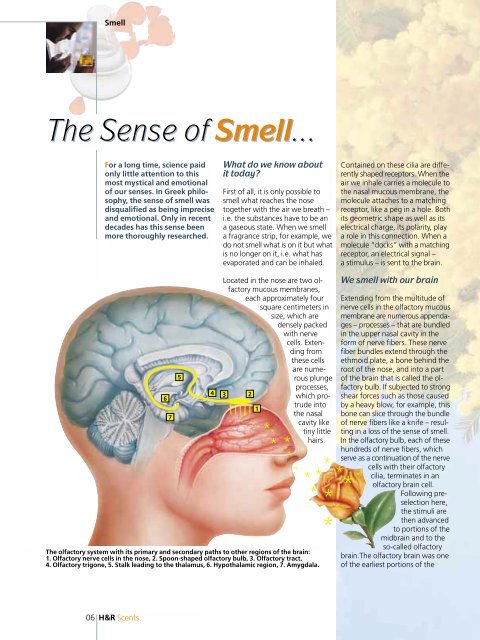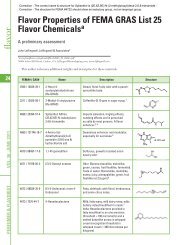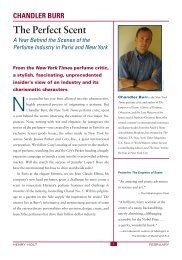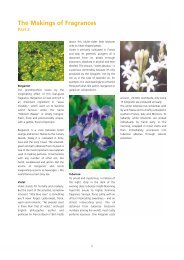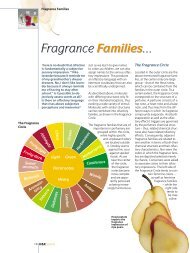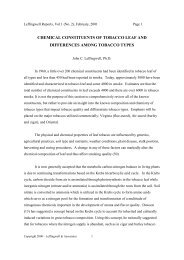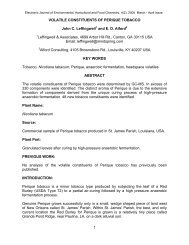The Sense of Smell - Leffingwell & Associates
The Sense of Smell - Leffingwell & Associates
The Sense of Smell - Leffingwell & Associates
Create successful ePaper yourself
Turn your PDF publications into a flip-book with our unique Google optimized e-Paper software.
<strong>Smell</strong><br />
<strong>The</strong> <strong>Sense</strong> <strong>of</strong> <strong>Smell</strong>...<br />
For a long time, science paid<br />
only little attention to this<br />
most mystical and emotional<br />
<strong>of</strong> our senses. In Greek philosophy,<br />
the sense <strong>of</strong> smell was<br />
disqualified as being imprecise<br />
and emotional. Only in recent<br />
decades has this sense been<br />
more thoroughly researched.<br />
What do we know about<br />
it today?<br />
First <strong>of</strong> all, it is only possible to<br />
smell what reaches the nose<br />
together with the air we breath –<br />
i.e. the substances have to be an<br />
a gaseous state. When we smell<br />
a fragrance strip, for example, we<br />
do not smell what is on it but what<br />
is no longer on it, i.e. what has<br />
evaporated and can be inhaled.<br />
Contained on these cilia are differently<br />
shaped receptors. When the<br />
air we inhale carries a molecule to<br />
the nasal mucous membrane, the<br />
molecule attaches to a matching<br />
receptor, like a peg in a hole. Both<br />
its geometric shape as well as its<br />
electrical charge, its polarity, play<br />
a role in this connection. When a<br />
molecule “docks” with a matching<br />
receptor, an electrical signal –<br />
a stimulus – is sent to the brain.<br />
6<br />
7<br />
5<br />
4<br />
Located in the nose are two olfactory<br />
mucous membranes,<br />
each approximately four<br />
square centimeters in<br />
size, which are<br />
densely packed<br />
with nerve<br />
cells. Extending<br />
from<br />
these cells<br />
are numerous<br />
plunge<br />
3<br />
2<br />
1<br />
**<br />
*<br />
processes,<br />
which protrude<br />
into<br />
the nasal<br />
cavity like<br />
tiny little<br />
hairs.<br />
<strong>The</strong> olfactory system with its primary and secondary paths to other regions <strong>of</strong> the brain:<br />
1. Olfactory nerve cells in the nose, 2. Spoon-shaped olfactory bulb, 3. Olfactory tract,<br />
4. Olfactory trigone, 5. Stalk leading to the thalamus, 6. Hypothalamic region, 7. Amygdala.<br />
*<br />
*<br />
*<br />
* *<br />
*<br />
*<br />
* * *<br />
*<br />
* *<br />
*<br />
We smell with our brain<br />
Extending from the multitude <strong>of</strong><br />
nerve cells in the olfactory mucous<br />
membrane are numerous appendages<br />
– processes – that are bundled<br />
in the upper nasal cavity in the<br />
form <strong>of</strong> nerve fibers. <strong>The</strong>se nerve<br />
fiber bundles extend through the<br />
ethmoid plate, a bone behind the<br />
root <strong>of</strong> the nose, and into a part<br />
<strong>of</strong> the brain that is called the olfactory<br />
bulb. If subjected to strong<br />
shear forces such as those caused<br />
by a heavy blow, for example, this<br />
bone can slice through the bundle<br />
<strong>of</strong> nerve fibers like a knife – resulting<br />
in a loss <strong>of</strong> the sense <strong>of</strong> smell.<br />
In the olfactory bulb, each <strong>of</strong> these<br />
hundreds <strong>of</strong> nerve fibers, which<br />
serve as a continuation <strong>of</strong> the nerve<br />
cells with their olfactory<br />
cilia, terminates in an<br />
olfactory brain cell.<br />
Following preselection<br />
here,<br />
the stimuli are<br />
then advanced<br />
to portions <strong>of</strong> the<br />
midbrain and to the<br />
so-called olfactory<br />
brain.<strong>The</strong> olfactory brain was one<br />
<strong>of</strong> the earliest portions <strong>of</strong> the<br />
06 H&R Scents
Only his enormous<br />
olfactory<br />
memory enables<br />
this perfumer<br />
to translate a<br />
fuzzy sensory<br />
perception<br />
into a concrete<br />
fragrance.<br />
cerebrum to develop, which in<br />
turn is linked with the limbic<br />
system, the system that controls<br />
our feelings and emotions.<br />
Interestingly enough, nerve<br />
impulses do not travel in only one<br />
direction – this area also contains<br />
nerve cells that work in the opposite<br />
direction. This means that there<br />
are a variety <strong>of</strong> ways in which a<br />
kind <strong>of</strong> feedback can modulate<br />
and modify the way a scent is perceived.<br />
Consequently, the expectations<br />
<strong>of</strong> the person who is smelling<br />
can exert a strong influence<br />
on the way a scent is experienced<br />
– yellow is associated with freshness,<br />
red with fruity sweetness.<br />
If this expectation is not fulfilled,<br />
the scent is frequently rejected,<br />
even though it is not really unpleasant.<br />
So a product’s olfactory acceptance<br />
is also highly dependent<br />
upon the right kind <strong>of</strong> packaging!<br />
<strong>The</strong> intensity <strong>of</strong> a scent, too, can<br />
influence its acceptance. This is<br />
because not every stimulus that is<br />
triggered by a molecule actually<br />
reaches the brain. <strong>The</strong> number <strong>of</strong><br />
molecules that are necessary for<br />
this to happen (which is termed<br />
the olfactory threshold) depends<br />
upon the fragrance material in<br />
question. In highly concentrated<br />
form, fragrance materials are <strong>of</strong>ten<br />
perceived as pungent. In this case,<br />
the nose would appear to be overstimulated<br />
– molecules are also<br />
deposited on the “wrong” receptors,<br />
thus triggering olfactory confusion,<br />
a “blurry” smell. In diluted<br />
form, on the other hand, they seem<br />
delightfully floral or fruity! A floral<br />
fragrance would have to be<br />
diluted to 2 to 5% to equal the<br />
strength <strong>of</strong> its natural counterpart.<br />
<strong>The</strong> sense <strong>of</strong> smell addresses both<br />
our emotions and our intellect.<br />
A scent’s stimuli are advanced to<br />
the right half <strong>of</strong> the brain, where<br />
it is recognized, while intellectual<br />
activity or the ability to associate<br />
a name occurs in the left half.<br />
This explains the phenomenon <strong>of</strong><br />
being able to precisely identify<br />
a scent but not its name.<br />
Aromatherapy utilizes the emotional<br />
side <strong>of</strong> our sense <strong>of</strong> smell<br />
and employs essential oils to produce<br />
a calming effect, e.g. through<br />
vanilla extract, or to stimulate the<br />
mind, e.g. with citrus oils. Scents<br />
can also be used as a source <strong>of</strong><br />
subconscious manipulation.<br />
In Japan, for example, it is not<br />
infrequent for essential oils to be<br />
distributed through the air conditioning<br />
system in order to relax<br />
employees during<br />
their breaks.<br />
A molecule<br />
serves<br />
as the origin<br />
<strong>of</strong> a fragrance<br />
impression.<br />
H&R Scents 07


